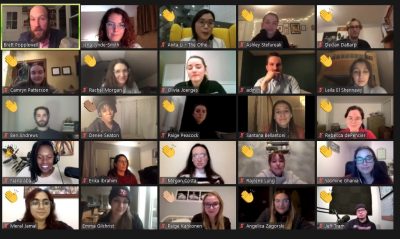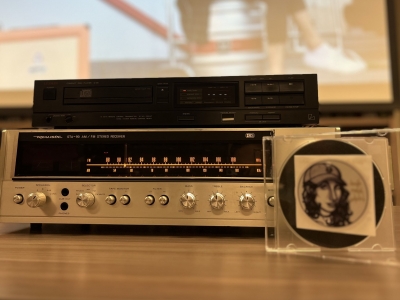By Jena Lynde-Smith

Clockwise from top left: Nana aba Duncan; Christopher Curtis; Emma Gilchrist and Anita Li.
Four entrepreneurial journalists took time away from their own media creations to join students in an interactive conversation to outline different ways that journalists are breaking out of legacy newsrooms and shaking up the industry with their own ventures.
Nana aba Duncan, Anita Li, Christopher Curtis and Emma Gilchrist joined a panel to share entrepreneurial insights with students before moving into smaller breakout sessions to network and workshop their own ideas for entrepreneurial new media launches.
The Feb. 10 event, Media Makers & Entrepreneurial Journalists — An Interactive Conversation, was organized by the Future of Journalism Initiative (FJI). Brett Popplewell, assistant professor and FJI Director, collaborated with Li to organize the event. Students from Popplewell’s course, Freelancing for Media Professionals, were among those in attendance.
“It’s paramount that we teach our students how to find their way in journalism outside a traditional newsroom,” said Popplewell. “Be that as freelancers or as creators of their own media outlets. We’re living in a time where the big legacy players are getting smaller. But there are all these new outlets emerging with 21st century business models and new ways of serving entire communities and audiences.”
The event began by giving each entrepreneur the opportunity to discuss their business. Carleton MJ grad Anita Li kicked off the event. Li is a media consultant and creator of The Other Wave, a newsletter about challenging the status quo in Canadian Journalism. She said if she could give one piece of advice to students it would be to diversify your skillset.
“Even if you’re only interested in becoming a reporter, don’t be afraid to learn about multiplatform approaches to delivering journalism, audience engagement, the business side of media and more,” Li said. My career path has evolved a lot over time, so I’m grateful for the fact that I was always willing to learn new skills along the way because this growth mindset became a big asset for me,” she said.
 CBC Radio host Nana aba Duncan is the creator of Media Girlfriends, a podcast company, network and student scholarship. It is focused on allowing for more perspectives in Canadian media, particularly those of Black, Indigenous and people of colour. Duncan said that she started the venture with no intention of making money but rather to fulfill a personal mission of hers.
CBC Radio host Nana aba Duncan is the creator of Media Girlfriends, a podcast company, network and student scholarship. It is focused on allowing for more perspectives in Canadian media, particularly those of Black, Indigenous and people of colour. Duncan said that she started the venture with no intention of making money but rather to fulfill a personal mission of hers.
“I want to foster an environment where racialized journalists, at every single stage in their career, can feel comfortable to do their work and to know that their perspectives and their communities are just as legitimate and worth as the perspectives and communities of white people,” Duncan said.
Duncan said that caring about what you’re reporting on is key. She told students to always strive for excellence.
“Excellence is number one. Do your best wherever you are,” she said.
Christopher Curtis is a former Montreal Gazette reporter and creator of The Rover, an interactive reporting project. He spoke about his journey from working in construction to starting his own media venture. He said that as a college dropout, he didn’t think he could make it as a journalist.
“I thought it was for people that were smarter than me,” he said.
Curtis said that after getting into the journalism program at Concordia University he adopted a highly driven attitude. He said he would give his all to every project and that following this mantra throughout his career is what has made him so successful.
“You’re a journalist. Don’t ask for permission. Don’t lose that hunger,” he said.
Emma Gilchrist, is an editor, public speaker and co-founder of The Narwhal, a non-profit magazine that tells stories about Canada’s natural world. Gilchrist spoke about how she left the Calgary Herald to work in the non-profit sector, where she stayed for five years.
“I was told at that time that I would never work in journalism again,” she said.
Gilchrist suggested spending time in the non-profit sector to learn how to monetize a media creation.
“I ended up learning everything I need to know about how to run a news organization,” she said. “I learned how to raise money, how to build a list, how to work the ladder of engagement and also made a lot of good connections.”
After each panelist spoke about their ventures, students were split into groups and given time to network with business owners. During the session, students said they felt inspired, excited and motivated. Raylene Lung, a second-year master of journalism student, said the event left her feeling gratified.
“The guest speakers were honest and real and filled with intelligent advice to offer us,” Lung said. “I thoroughly enjoyed the event and not only had fun but was grateful to privy to the amazing insights they gave. I loved hearing each of their inspiring experiences. I felt fulfilled afterwards.”
Friday, February 12, 2021 in 2021, General, Journalism News
Share: Twitter, Facebook



